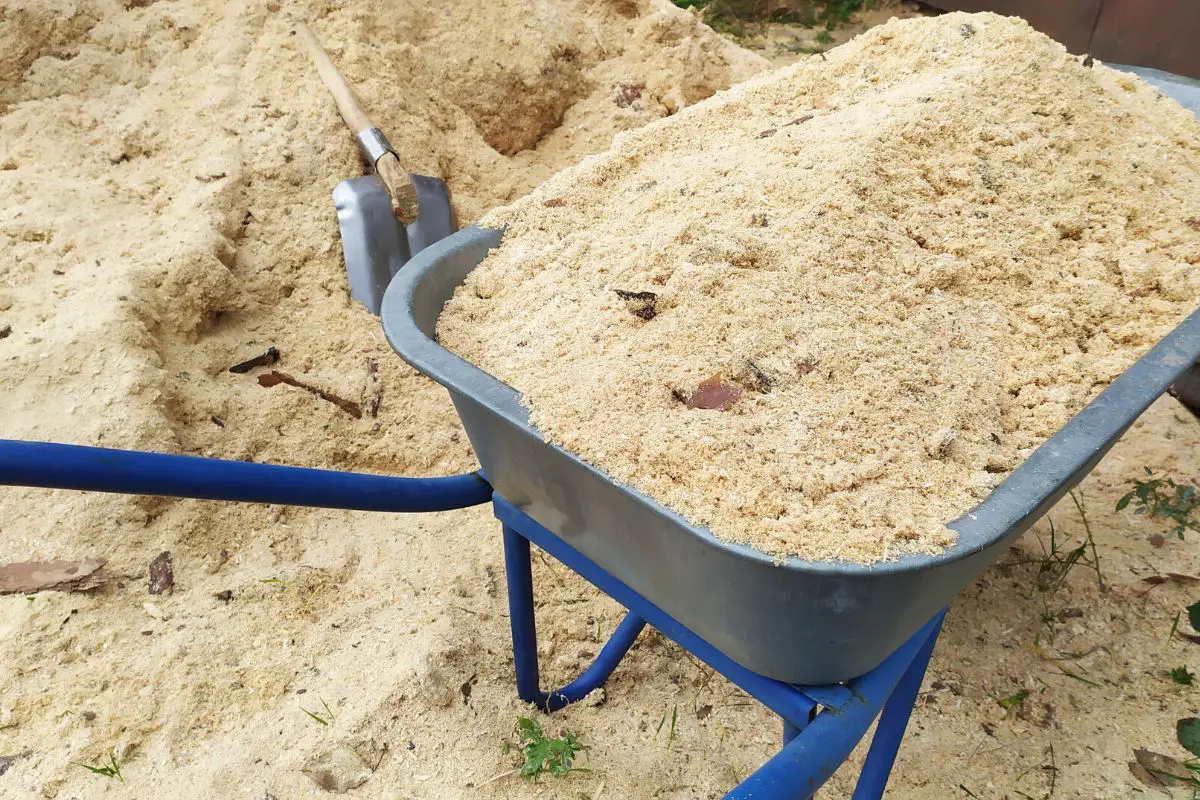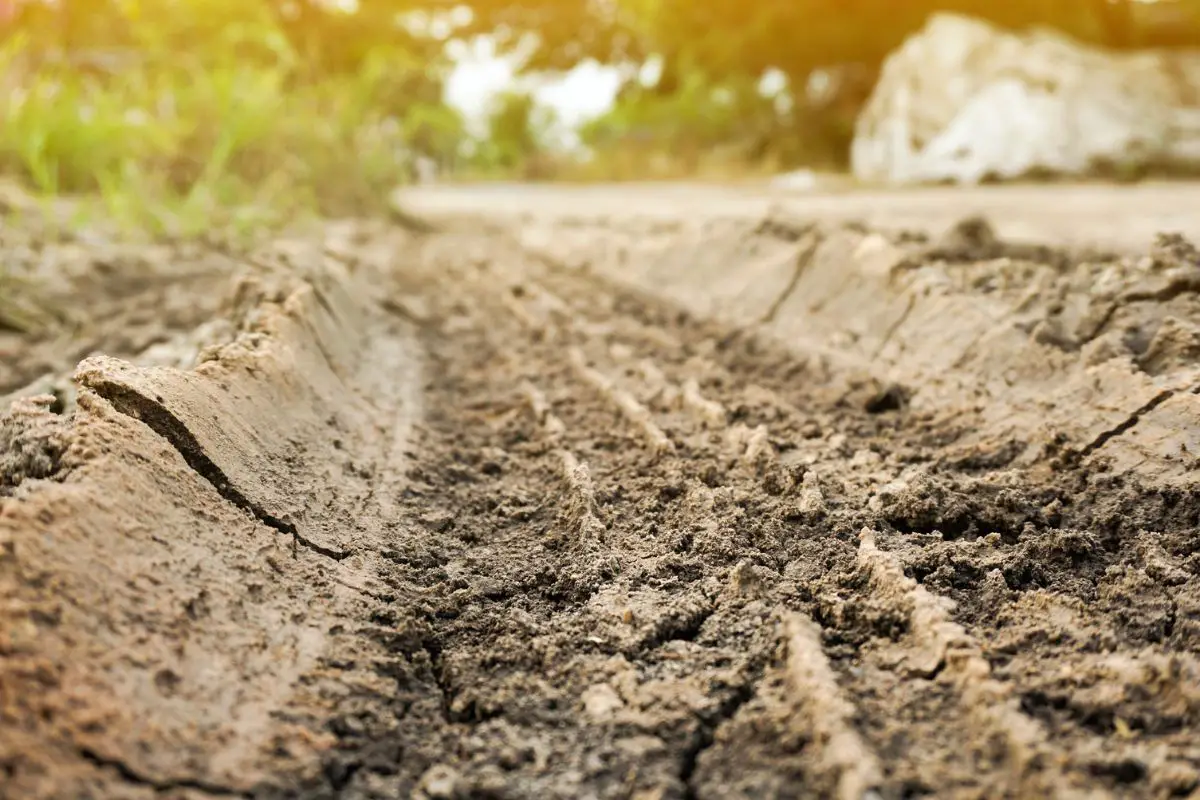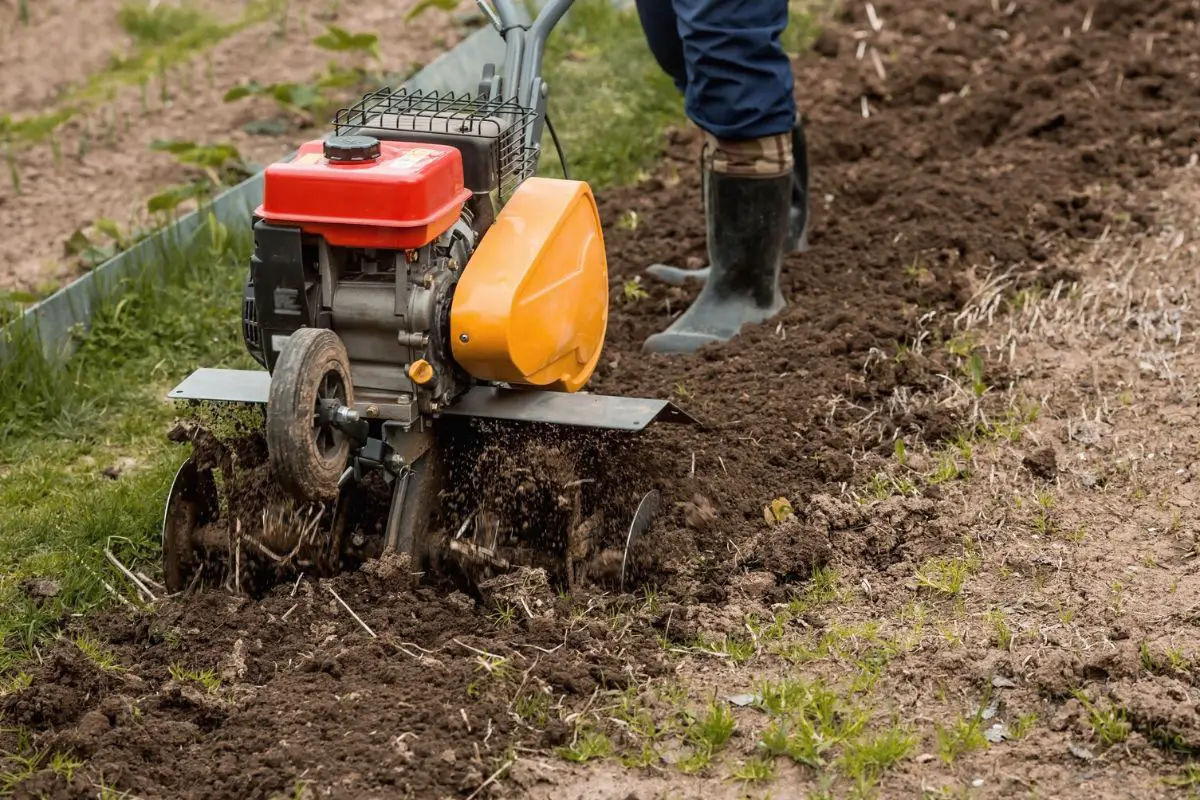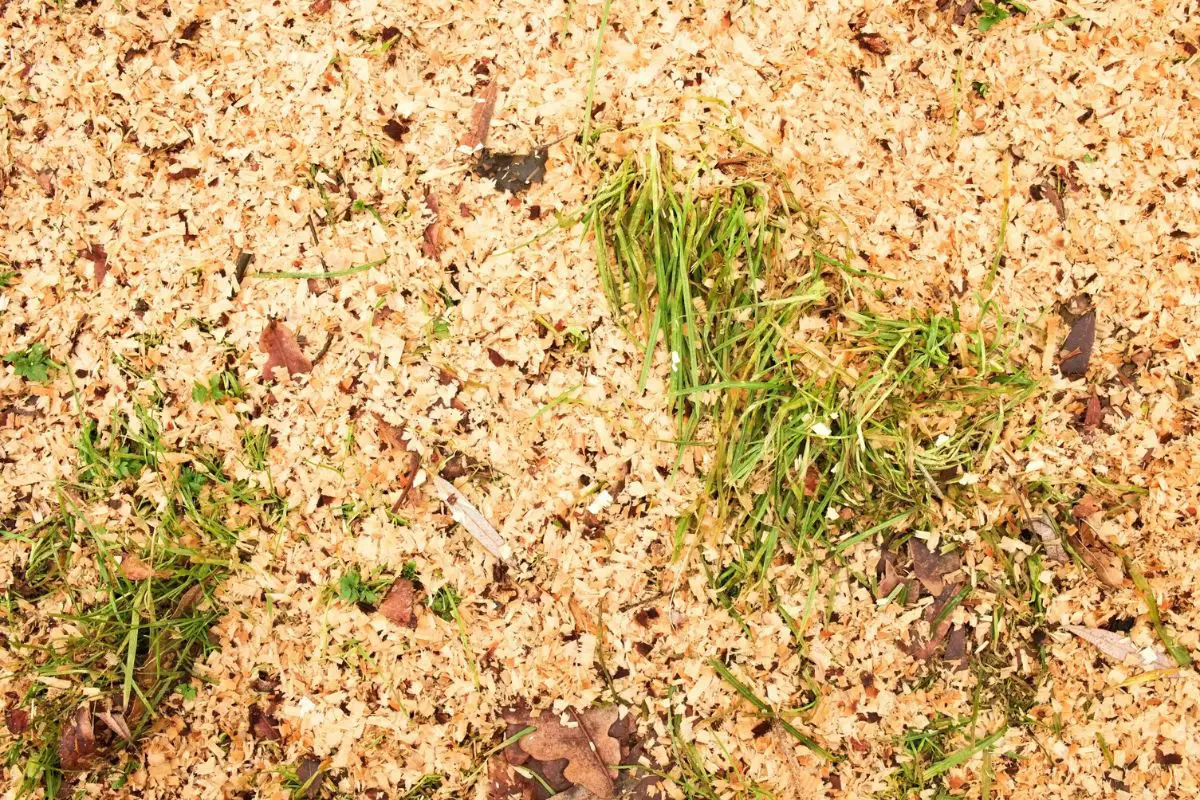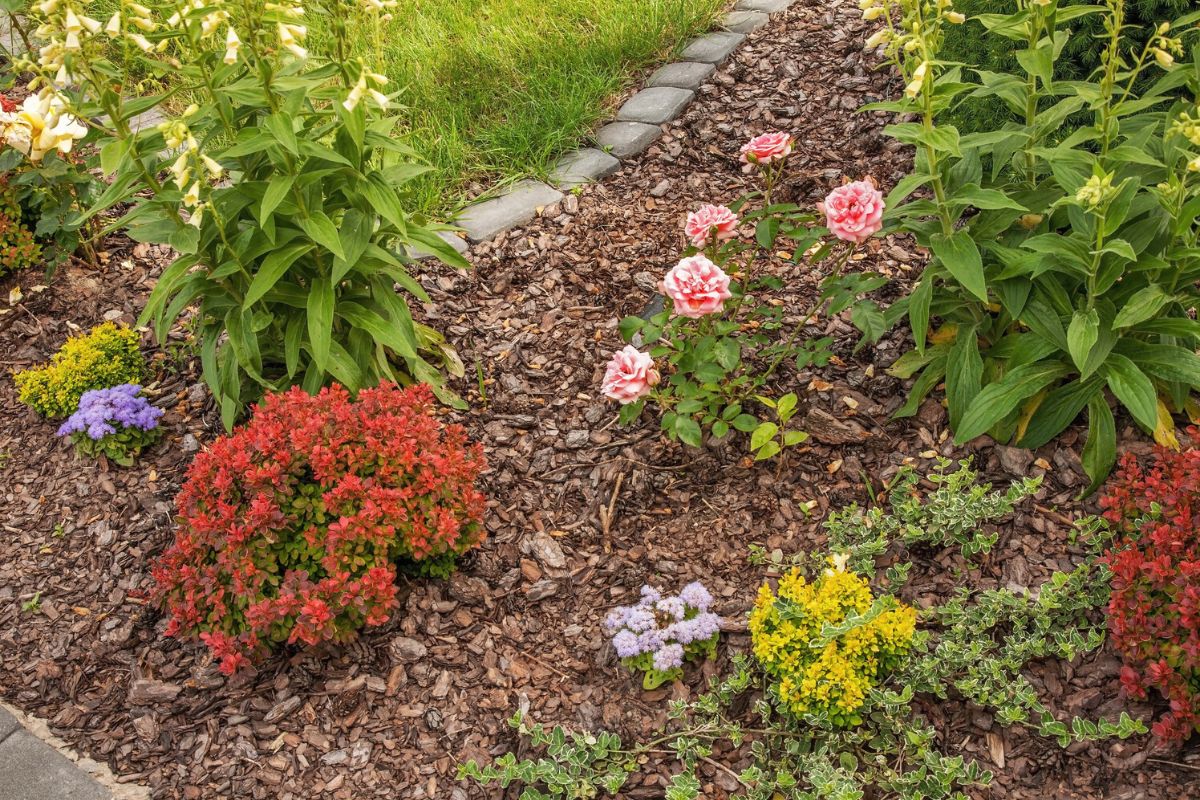Growing your own vegetable garden is a rewarding experience, especially after reaping the fruits of your labor. Growing vegetables that are not native to your area doubles the amount of work you must put into maintaining the garden. Thankfully, organic mulches can help improve the conditions around your plants.
The best organic mulch for vegetable gardens is homemade compost. Composting at home will help you control what goes into your soil and, ultimately, into your food. Straw, sawdust, grass clippings, and dried leaves are other suitable alternatives.
The rest of the article will discuss what organic mulches are, how they benefit your vegetable garden, and the best options to use. I will also share the best practices for application and maintenance to maximize the quality and yield of your vegetables. Let’s dive in!
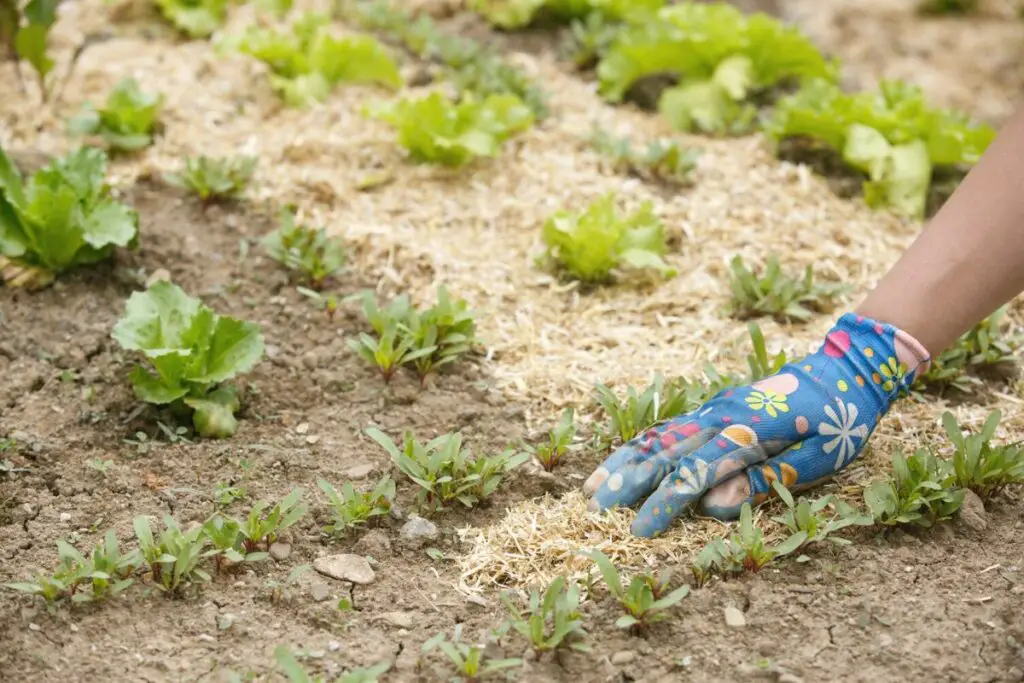
Organic Mulches: An Overview
As a new gardener, you may have come across suggestions from online sources or experienced gardeners to use mulch. Mulch is a general term for materials that you can use to keep your plants safe from the elements, especially in regions they’re not native to.
Different types of plants may do better with certain types of mulch than others. That said, there are two major types of mulches commonly used in a garden: organic and inorganic.
Organic mulches are materials that come from living matter. As they decompose, they release components that can increase the organic matter and nutrients in the soil. Because of this, many gardeners prefer using them in farms or home gardens.
Below is a list of widely used organic mulches:
- Compost
- Straw
- Hay
- Wood chips
- Bark mulch
- Grass clippings
- Leaf mulch
- Cocoa hulls
- Cover crops (e.g., clover, alfalfa)
- Seaweed
- Pine needles
- Mushroom compost
- Rice hulls
- Sawdust
Note that not all of the options listed above can be used in vegetable gardens. For instance, seaweed mulch can be too salty and dehydrate vegetable seeds and seedlings. Meanwhile, hay can contain weed seeds.
On the other hand, inorganic mulches don’t readily break down in the soil. They’re often made from synthetic materials, such as plastic and rubber. Non-living materials like stones, rocks, and gravel are also commonly used as inorganic mulch.
Inorganic materials work well and can be reused, but plastic and rubber can physically break apart due to heavy rain or intense heat and infiltrate the soil. In addition, they are not breathable and can prevent proper water penetration into the soil.
Therefore, it’s always best to use organic mulch in vegetable gardens.
Benefits for Growing Vegetables
Between the two types of mulches, you’ll reap more benefits from using organic materials in a vegetable garden. Inorganic mulches are mainly used for weed suppression and aesthetics, whereas organic mulches have more advantages.
Let’s look into each of the benefits below:
Soil Moisture Retention
The soil in an outdoor vegetable garden needs to be well-draining to protect your plant’s roots from water-logged conditions. As such, many gardeners amend the clayey garden soil with sand to improve drainage because dehydration is much easier to address than root rot.
However, because of this, the soil can quickly lose moisture under hot and dry conditions. Applying mulch is one of the best ways to achieve a balance between drainage and moisture retention, as it prevents excessive soil moisture loss due to evaporation.
Organic mulches have a significant advantage compared to inorganic mulches because they allow proper moisture penetration. They facilitate adequate hydration of the root zone and keep it moist until the roots absorb all the moisture they need.
In contrast, you’ll need to install a drip irrigation system when using plastic or rubber mulch. Although drip irrigation is advantageous in many cases, using synthetic mulches will prevent you from taking advantage of rainwater.
If your area receives a good amount of rain in the spring and summer, it’s best to use organic mulches to avoid losing rainwater through runoff. Rainwater, after all, is the best water source for any plant, whether indoors or outdoors.
Weed Suppression
Depending on the type of organic material, a 2-4 inch (5-10 cm) layer of mulch on bare soil around your vegetable patch is usually effective in suppressing weed growth. This will ensure your vegetables don’t have to compete for soil moisture and nutrients.
Some pesky annual weeds will still try to grow through the mulch if airborne seeds land on the mulch surface or the seeds are brought to the surface because of tilling. Luckily, they’re easy to spot and uproot.
Be sure to inspect your garden regularly and pull out annual weeds, such as crabgrass and foxtail, while they’re small. Otherwise, they’ll have enough time to grow, go to seed, and reinfest your garden the following year.
Perennial weeds like bermudagrass with existing rhizomes underground typically will have a hard time growing through the mulch layer due to the lack of sunlight. The key is to apply the mulch early in spring or fall before warm or cool-season weeds sprout.
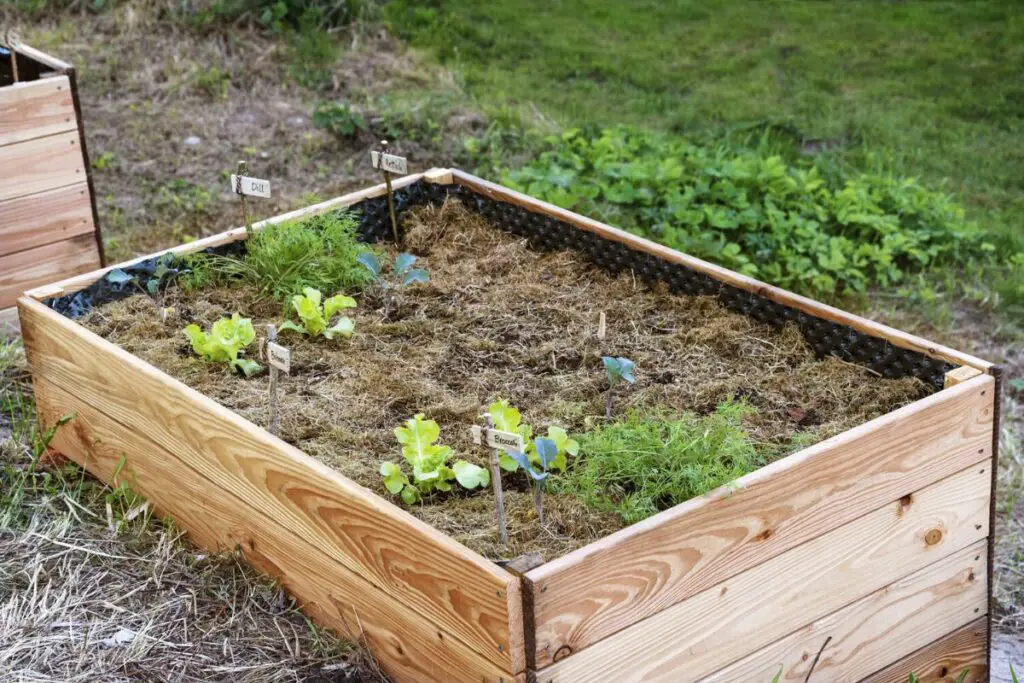
Temperature Regulation
Organic mulches help keep the roots warm during cold temperatures and cool during hot days. They protect the soil from drastic temperature changes due to fluctuating environmental conditions.
A well-managed organic mulch layer allows efficient air circulation through the pores to help maintain desirable temperatures within the soil.
In addition, the increased moisture retention keeps the soil temperatures stable since water and soil particles don’t change temperatures as quickly as air. Together, these properties enable the soil underneath the mulch to release excess heat or retain it as needed.
Plastic and rubber mulches, on the other hand, can heat up the soil excessively. This is especially true with black plastic, which absorbs and traps heat underneath it.
As a result, your plant’s roots will experience heat stress, and your vegetables will have poor growth or yield. Commonly grown leafy vegetables, such as spinach and lettuce, can bolt when constantly exposed to high temperatures (over 70 °F or 21 °C).
Bolting is a defense mechanism many vegetable plants go through, which involves prematurely forming flowers to produce seeds. This process will leave you with bitter-tasting and inedible vegetables.
Luckily, you can prevent or delay bolting in your vegetable garden using organic mulch.
Nutrient Enrichment
Many popular vegetables, such as potatoes, tomatoes, and squash, are heavy feeders and will consume large amounts of nutrients during the growing season.
Green organic mulches like pine needles, leaves, and grass clippings can release nitrogen into the soil as they decompose. Woody mulches like bark and sawdust, on the other hand, can increase the soil’s organic matter and improve the soil’s nutrient-holding capacity.
Therefore, using organic mulches that help maintain your soil’s health and biological activity will ensure your soil is rich enough for another growing season.
Some gardeners might be worried about woody mulches stealing nitrogen from the soil.
Although it’s true that soil microbes need nitrogen to break down these materials, you can avoid nutrient deficiency issues by applying the following preventive measures when using woody mulches:
- Apply nitrogen or any fertilizers directly into the root zone.
- Grow nitrogen-fixing vegetables, such as beans and peas.
- Grow vegetables that don’t require much nitrogen, such as root crops like carrots, potatoes, and beets.
Soil Erosion Prevention
Heavy rains and strong winds can cause soil erosion. A 2-4 inch (5-10 cm) mulch layer over your garden soil can protect your soil from the compacting or eroding impact of heavy rains. It can also prevent the wet soil from splashing back into your vegetable’s foliage.
The organic mulch layer also maximizes the amount of water that goes into the soil by preventing runoff. The soil particles that remain intact underneath the mulch can then absorb the water, which goes directly into the root zone.
In addition, a mulch layer will protect the soil surface from drying out, reducing dust problems. However, ensure that lightweight mulch materials, such as sawdust and straw, are well-hydrated to keep them from being blown away by the wind.
8 Best Organic Mulch Types and Characteristics
Although all organic mulches can provide the abovementioned benefits, each one has distinct characteristics that make them superior or inferior to others.
The list below explains the best organic mulches you can use in a vegetable garden.
Compost
Compost is arguably the best organic mulch you can use for a vegetable garden. When fully decomposed, it can double as a fertilizer. It’s also economical and eco-friendly because you can make it at home using plant-based kitchen scraps and yard waste.
As mulch, partially finished compost beats the other organic options through the following qualities:
- It has excellent temperature-regulation properties because it is breathable and holds moisture well. As discussed, air circulation and moisture-holding are crucial to keep the soil temperature stable around the plant’s roots.
- The dark, earthy color of compost provides a stark contrast with your vegetable plants’ foliage and gives it a very natural aesthetic.
- It has plenty of nutrients available for the plants. It works as a slow-release fertilizer because the nutrients are brought to the root zone every time you water your plants.
If anything, the only downside of using compost is that it’s not as effective as other mulch materials in suppressing weeds. The nutrient-rich nature of compost makes it a suitable substrate for weed seeds to grow through it.
You can often keep it under control by pulling the weeds out from the roots as soon as you spot them.
You’ll also need to replenish it regularly to maintain its effectiveness as mulch because it can quickly lose an inch (2.5 cm) of thickness every few months as it degrades and mixes with your garden soil.
On another note, it’s also important to consider the pH of your compost before using it in your vegetable garden. Depending on your source materials, compost can have a wide range of pH. Although it won’t quickly alter your soil pH when applied only on the soil surface, you must still check the pH of your compost when using it over seeds.
Extreme acidity or alkalinity (below 5.5 or over 8.0) can be bad for your vegetable seeds or seedlings. Regular watering will release the nutrients more quickly and result in changes in the pH of the seed layer if planted very close to or on the soil surface.
Knowing the pH of your compost will help determine which seeds will benefit from it because some vegetables prefer acidic soil while others can tolerate alkaline soil.
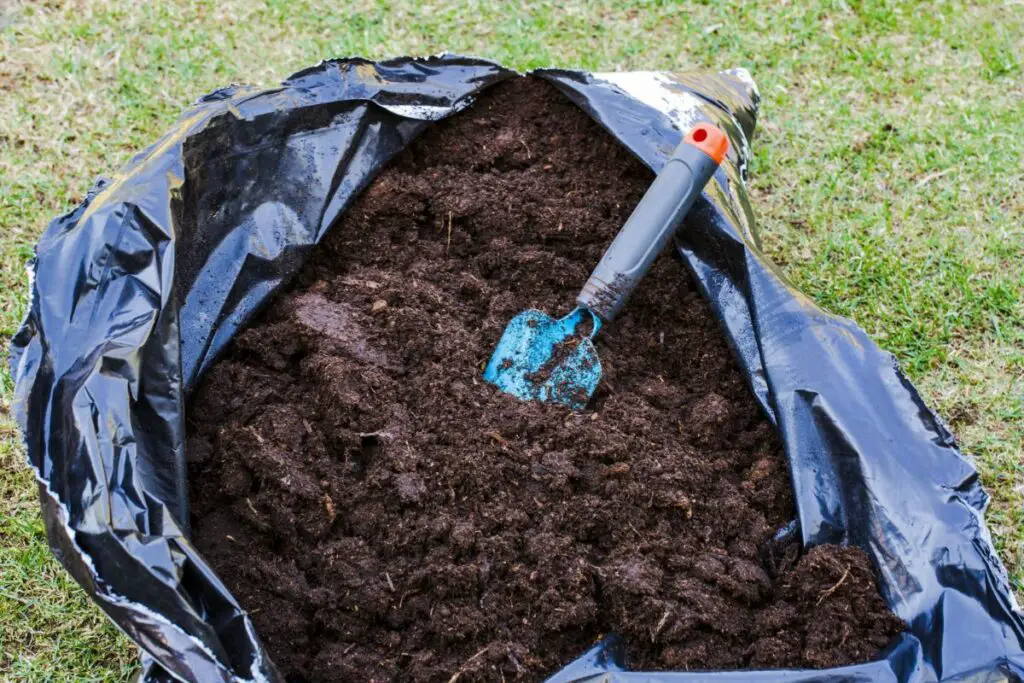
Straw
Straw mulch comes from dried grain stalks, such as wheat, rye, and oats. It shouldn’t be confused with hay, which is dried grass, including the leaves and seed heads. That said, straw is better than hay for a vegetable garden because it hardly contains weed seeds.
While it’s true that straw mulch can sometimes contain weed seeds, you can avoid the issue by acquiring it from reputable sources. Gardening supply stores that sell straw specifically for mulch use understand the struggle of dealing with weeds and are unlikely to sell straw with seed heads.
One way to ensure that your mulch doesn’t have weed seeds is by inspecting that your straw pile is purely stalk without leaves or seed heads.
I’ve had much success with using straw mulch in my vegetable garden because it’s effective in keeping weeds at bay. In addition, it has excellent moisture retention and temperature regulation properties.
I also quite love the light hue of freshly applied straw mulch against the rich greenery in my vegetable garden.
However, there are a few things to consider when using this organic material:
- Straw is lightweight and has to be well-hydrated to keep it from being blown away by the wind.
- Over time, the mulch will take on a slightly darker hue and become less attractive.
- It can take about 6-12 months for straw mulch to decompose in a well-maintained garden, and once it does, it can consume some nitrogen sources in the soil.
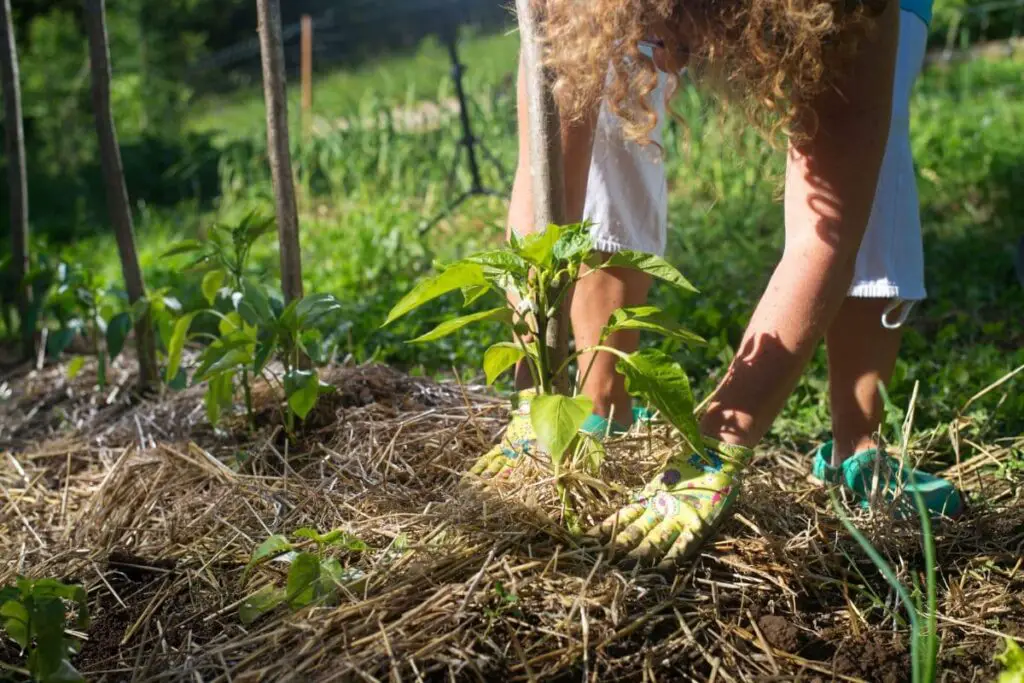
Grass Clippings
If you have a lawn and a surplus of grass clippings from religiously mowing it, you can bag some of the clippings and apply them to your vegetable garden as mulch.
Grass clippings are rich in nitrogen and will decompose on your vegetable garden within one growing season, provided you maintain your garden well. As they break down, they will release some nutrients and add organic matter to your soil.
When applied at a depth of 2-4 inches (5-10 cm), grass clippings will provide your garden with all the benefits of mulch, ranging from moisture retention to insulation. The only downside is that it won’t be as visually appealing as other mulch materials.
There are just a few things you must keep in mind when using grass clippings as mulch:
- Ensure that the grass clippings come from a lawn that hasn’t been treated with herbicides.
- Use grass clippings that are less than 2 inches (5 cm) long to facilitate faster decomposition and avoid thatch buildup.
- Avoid using grass clippings when the lawn grass shows signs of going to seed because they will introduce weed seeds into your vegetable garden.
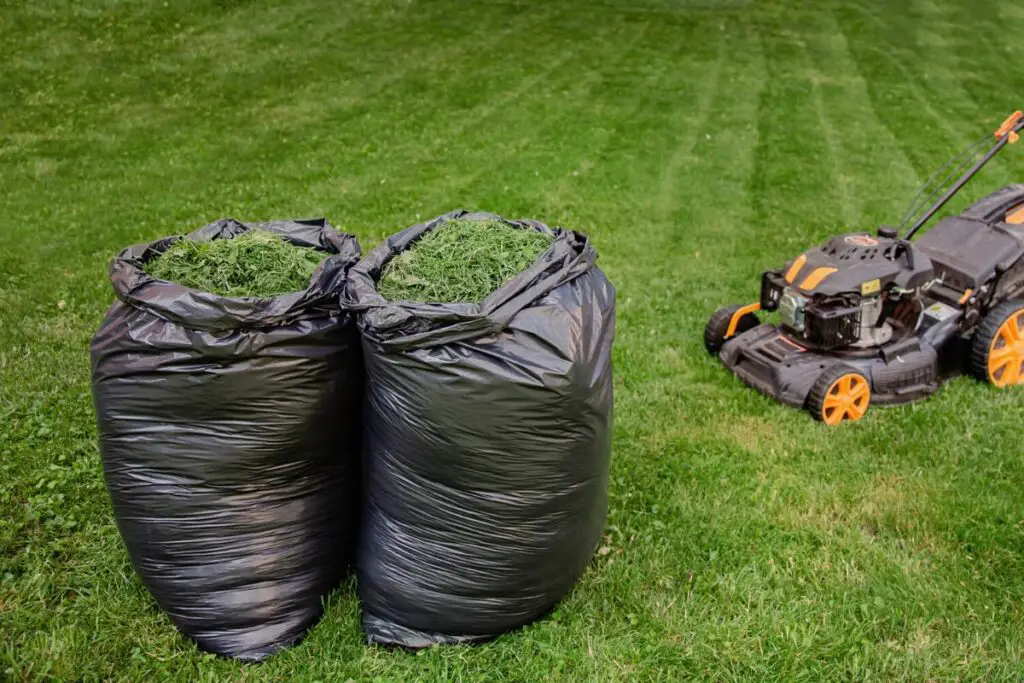
Sawdust
Sawdust can easily be sourced or purchased from sawmills or the lumber industry. It can come in the form of wood powder, shavings, or both. Although commonly generated as a waste product, sawdust has been widely used as fuel, in pet bedding material, or even as garden mulch.
When used in the vegetable garden, it presents the following advantages:
- The fine nature of sawdust allows it to hold onto moisture and keep the soil temperatures stable.
- It comes in a wide range of colors, ranging from cream to reddish brown, depending on the wood source.
- A thin layer of sawdust (up to 2 inches or 5 cm) is often enough to suppress perennial weed growth when applied early or before the growing season.
In order to maximize the benefits of using sawdust mulch in a vegetable garden, it’s crucial to keep the following considerations in mind:
- Limit the depth to 2 inches (5 cm) to avoid surface crusting. Very fine-grade sawdust can form an impenetrable crust when constantly wet.
- Pull out any annual weeds that sprout on the sawdust mulch layer as soon as you spot them. Sawdust doesn’t contain weed seeds but can catch airborne weeds from nearby gardens.
- Keep the mulch moist but not soggy to protect it from the wind.
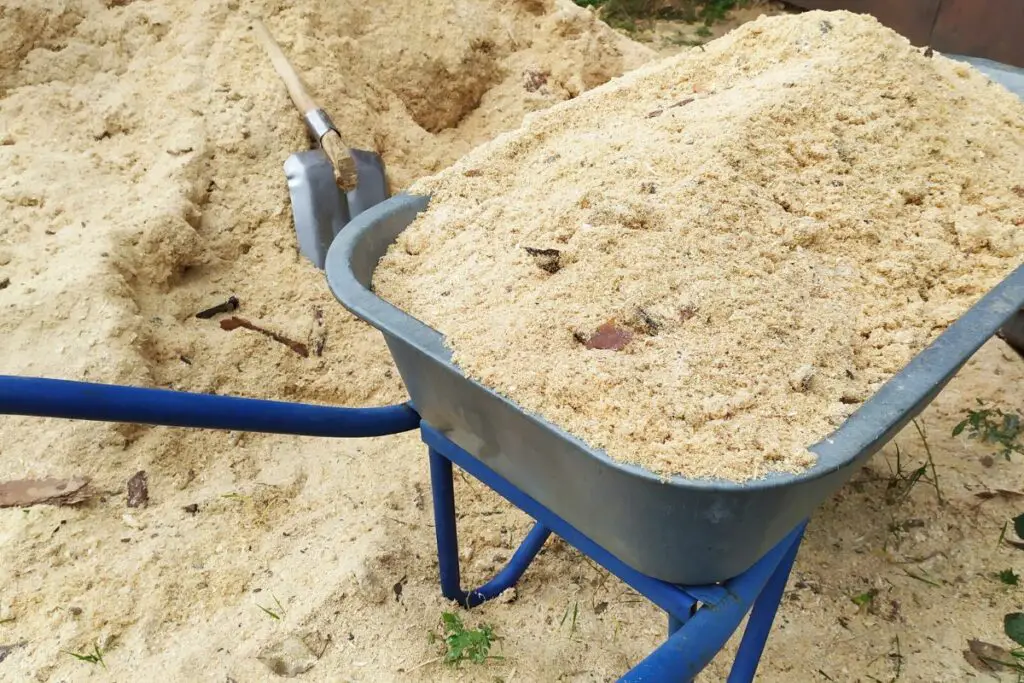
Dried Leaves
Dried leaves are the cheapest and most widely available organic materials you can use as mulch if you have a garden. They’re present in every garden and can be readily used because they decompose quickly.
As leaf mulch, they can provide your vegetable garden with all the benefits of organic mulch except for one thing: aesthetics. Dried leaf mulch can look unappealing and give off an image of a poorly maintained garden.
In addition, diseased or pest-infested fallen leaves can spread the issue to your vegetable garden. You can’t use leaves from trees or plants treated with pesticides, either.
If you prefer to use dried leaves, you can effectively do so by sun-drying them for at least 2 days and shredding them until they appear more uniform.
A 2-4 inch (5-10 cm) layer of shredded leaves decomposes faster than whole leaves. It also allows for better air circulation and water penetration.
Over time, with a proper watering routine, the leaf mulch will appear darker as it is incorporated into your soil. As it fully decomposes, it can introduce low but helpful amounts of potassium, calcium, and magnesium into the soil for your vegetables to consume.
Alternatively, if you have a surplus of dried leaves but don’t like their appearance as mulch, you can add them to your compost pile. As discussed, compost is probably the best organic mulch on the list.
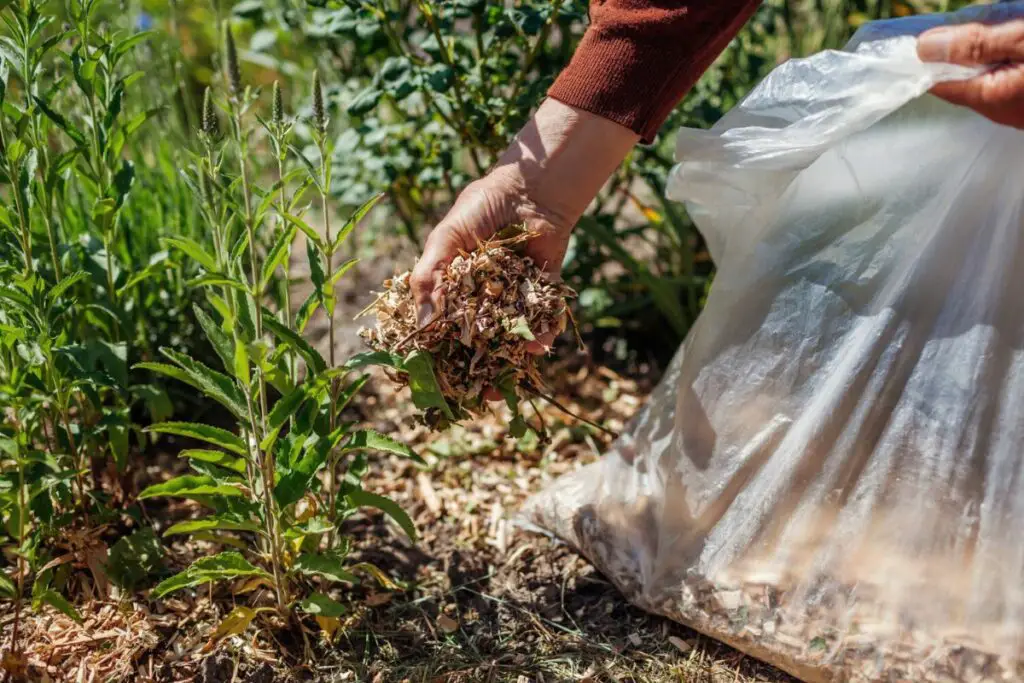
Pine Needles
If you have a coniferous garden or hedge, you likely have plenty of pine needles available. These fallen plant matter can also be useful as an organic mulch in a vegetable garden.
Their shape and texture make them suitable mulch materials because they allow water penetration, prevent runoff, and keep the soil temperatures stable. They also prevent splashing of dirt on heavy vegetable fruits, such as squash and melons.
Contrary to popular belief, pine needles don’t acidify the soil, especially when applied only as a mulch layer. You can safely place up to 3 inches (7.6 cm) of mulch around your vegetables and reap its protective benefits.
One thing to consider when using pine needles is that they decompose relatively slower than other organic mulches. They can take about a year to fully decompose, depending on how often you water your garden.
It’s common for partially decomposed mulch to be tilled into the soil after the growing season of annual vegetables. Doing so will complete the decomposition process quickly and introduce the organic matter into the topsoil to enrich it for the next growing season.
However, since pine needles break down slowly, they shouldn’t be incorporated into the soil while they’re still partially decomposed. That said, they’re best suited for perennial vegetables or fruit trees that don’t need frequent or regular tilling.
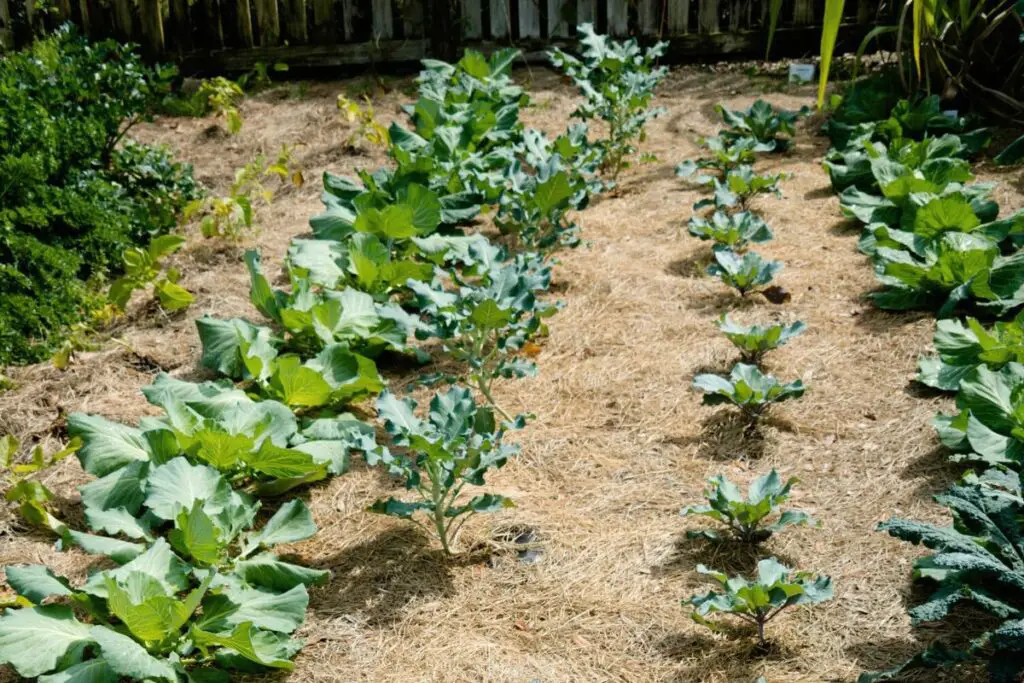
Bark and Wood Chips
Similar to pine needles, bark and wood chips also decompose slowly and can take 1-2 years to show signs of decomposition when applied as mulch. Therefore, they’re also more suitable for fruit trees.
Perennial vegetables like rhubarb and asparagus can also benefit from these types of mulch to ensure they’re safe from freezing temperatures and bounce back in the spring.
In cold regions, potatoes can safely stay in the ground over winter when properly mulched and you’ll see them sprouting again in spring. Ideally, when using wood chips or bark, mulch should be 2-4 inches (5-10 cm) thick for optimum protection.
You must put a marker on the spots where the vegetables are so they won’t struggle to grow through the thick mulch layer as the temperatures rise.
One downside of using woody mulches like wood chips and bark, however, is that they can invite subterranean termites or bugs to dwell underneath the mulch layer. The high moisture content of the soil underneath and the long-term stay of woody mulches on the soil surface give these bugs the impression that the area is safe for them to build colonies.
Termites might be more attracted to fruit trees than the woody mulch around them. Still, the protection the woody mulches give them makes the garden ideal for the termites to colonize.
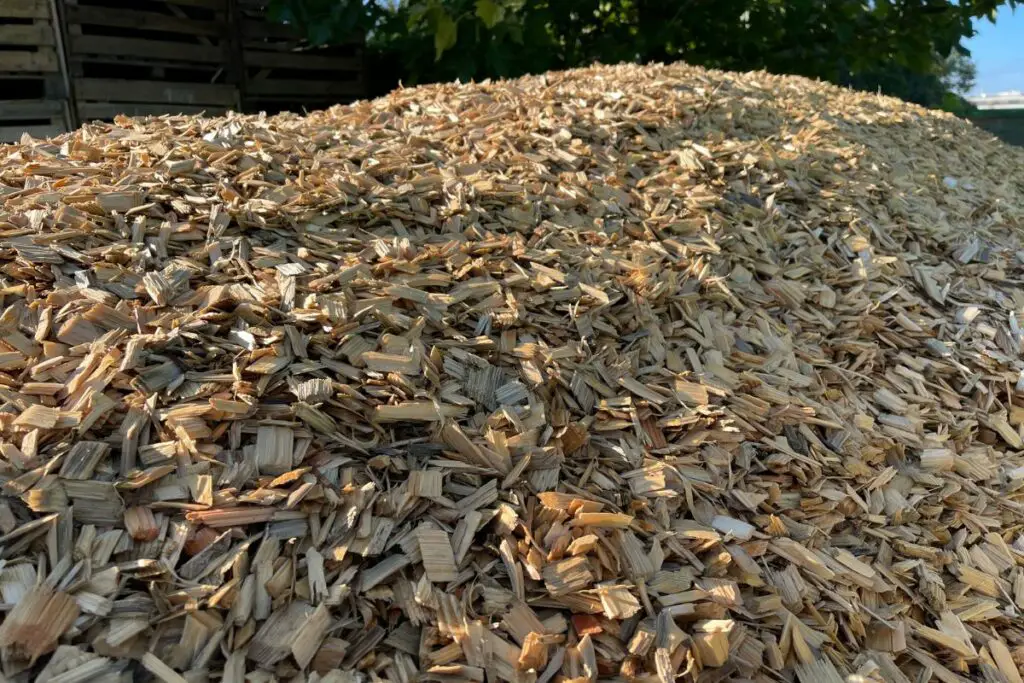
Cover Crops
If you don’t grow anything in your garden during the cold season due to unsuitable conditions, it’s crucial to grow cover crops to keep the soil healthy and weed-free. Cover crops can maintain the soil texture, prevent soil erosion, and enrich your soil for future crops.
One excellent winter cover crop is clover (Trifolium spp.). Red, white, or crimson clover can grace your otherwise bare vegetable garden in winter to prevent weeds from taking over.
I personally prefer using crimson clover (Trifolium incarnatum) if I want to take a break from vegetable gardening after my summer harvest. After clearing my garden of the spent annual vegetables, I sow crimson clover seeds about six weeks before the first fall frost.
They don’t require fertilizers and can actually return nutrients to your soil once they die out. If your area has freezing winters, your crimson clover will naturally die over winter, and you’ll just have to till it into the soil.
However, in warmer regions, they may thrive and flower in spring. Just make sure they don’t go to seed in your vegetable garden. To prevent this, you can mow or trim them to an inch (2.5 cm) when they show flowers.
You can bag the waste and add it to your compost pile and till the remaining plant matter into the soil. It’s best to do this about 4-6 weeks before sowing your spring vegetables.
Crimson clover is an excellent cover crop after using carbon-rich mulches like sawdust and straw. These materials will consume the nitrogen in the soil during decomposition. On the other hand, crimson clover doesn’t need much nitrogen from the soil.
As a legume, it can absorb nitrogen from the air using soil microbes and eventually convert it into forms your nitrogen-loving vegetables can readily use.
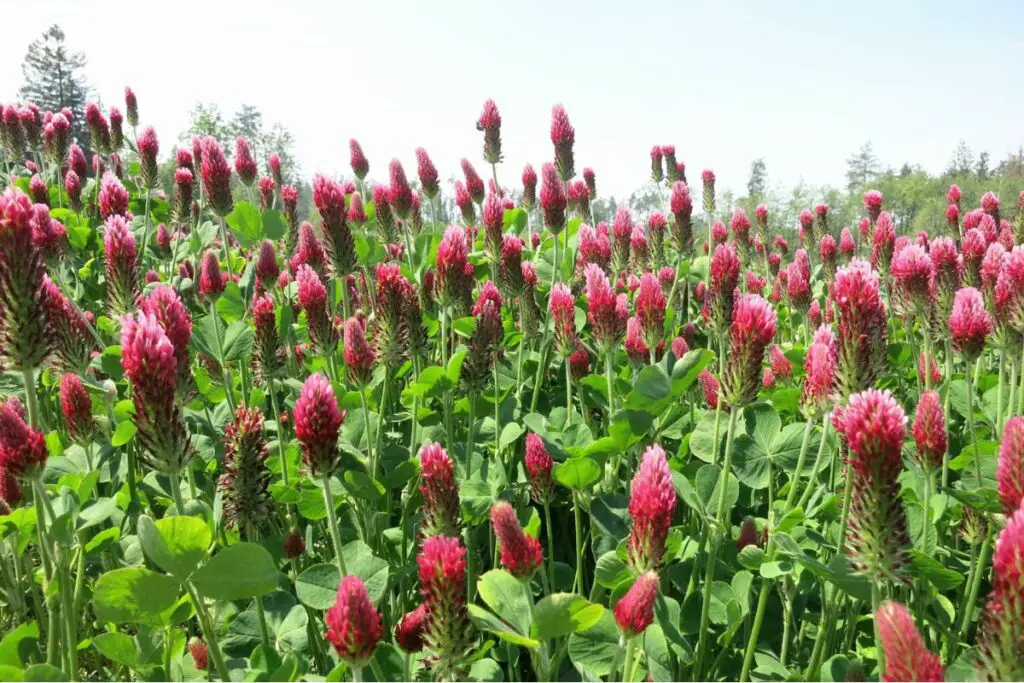
Matching Mulch to Garden Needs
Not all vegetable gardens are the same. The type of vegetables you want to grow, the climate in your region, and the soil type can all influence your decision on the type of mulch you must use.
Here are some tips on how to tailor your mulch choice to your vegetable garden’s needs:
Vegetable Types
Annual vegetables and your garden, in general, will benefit the most from organic mulches that decompose within one growing season (3-6 months), such as compost, sawdust, grass clippings, and shredded leaves.
If you practice crop rotation, you can till the decomposed mulch into the soil to enrich it and prepare it for the next crops. You can then apply a fresh layer of mulch for the new seeds or seedlings.
On the other hand, fruit trees and perennial vegetables can use longer-lasting mulch materials like wood chips, bark, and straw. These materials can last and remain effective on the soil for up to two years and don’t require to be replenished frequently.
About 4 inches (10 cm) of straw or wood chips is often enough to protect the roots of perennial vegetables from freezing temperatures as long as they remain below the frost depth.
Spacing
Ideally, regardless of the mulch or vegetable types, you must keep at least a 1-inch (2.5 cm) distance between your mulch and the plant’s stem or crown. Most organic mulches retain moisture, and steady contact between wet mulch and the vegetables can cause stem or crown rot.
Increasing the distance to 2 inches (5 cm) will give you enough space to work with when introducing fertilizers 1 inch (2.5 cm) deep into the root zone. This step is crucial to prevent potential nitrogen loss from carbon-rich mulches like sawdust, straw, bark, and wood chips.
With this in mind, straw and pine needles can be quite challenging to apply in a vegetable garden with narrow spaces between individual plants. The shape of the stalks and needles requires extra effort to prevent them from touching your plants.
Thankfully, they don’t remain wet for too long after the rain or regular watering. They let the water through and keep it within the soil below.
The light weight of shredded leaves can also make them difficult to maintain in their designated spots. On the other hand, partially finished compost, sawdust, wood chips, and bark are easy to keep in place at a suitable distance from the plants’ stems or crowns.
Nevertheless, as long as you keep a close eye on your vegetable garden and make adjustments whenever necessary, you can use any organic mulch on the list. You’ll just need to push the mulch away from the stem as the plant becomes thicker.
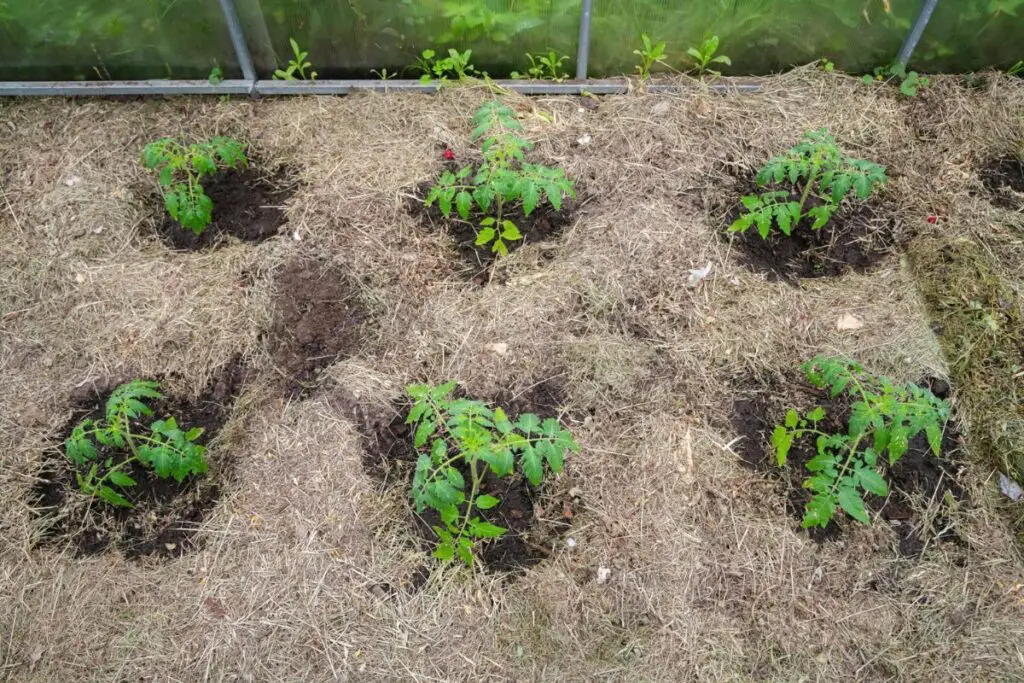
Climate and Region
If you live in colder regions with freezing temperatures, mulch materials like finished compost, sawdust, dried leaves, and grass clippings are likely not enough to protect the perennial vegetable roots from freezing winters.
These materials decompose quickly and will lose significant volume during freeze and thaw cycles in the winter. As a result, they won’t be able to insulate the soil effectively.
Therefore, it’s best to use longer-lasting and denser mulch materials like wood chips, bark, and straw to protect perennial vegetables in an outdoor garden over winter.
In warmer or temperate regions where winters don’t fall below 40 °F (4 °C), applying finer mulch materials will often suffice to prevent cool-season weeds from sprouting.
You can also apply 4 inches (10 cm) of partially finished compost in the fall because the decomposition process—albeit slower—will help keep the soil warm.
Soil Type and Condition
There are different types of soil based on texture. Vegetable gardens need soil that’s predominantly loamy with a good amount of sand. This combination provides an ideal balance among aeration, drainage, and moisture retention.
Realistically speaking, not all regions have the same type of soil. However, this shouldn’t prevent you from starting your own vegetable garden. Most garden soils only need a bit of amendment to make them suitable for gardening.
Although many gardeners don’t really mind using any organic mulch on any type of soil, there are actually a few extreme cases wherein you’ll need extra knowledge to maximize your harvest. This is often the case with regions that have predominantly sandy or clayey soil.
Sandy Soil
If you live in an area with sandy soil, you will need to apply up to 4 inches (10 cm) of organic mulch to prevent excessive moisture loss through evaporation.
Sand tends to trap heat and cannot hold moisture, so it’s essential to use mulch to allow the soil to breathe while ensuring the plant’s roots can access enough moisture before it’s lost due to heat. In this case, it’s best to avoid using sawdust mulch.
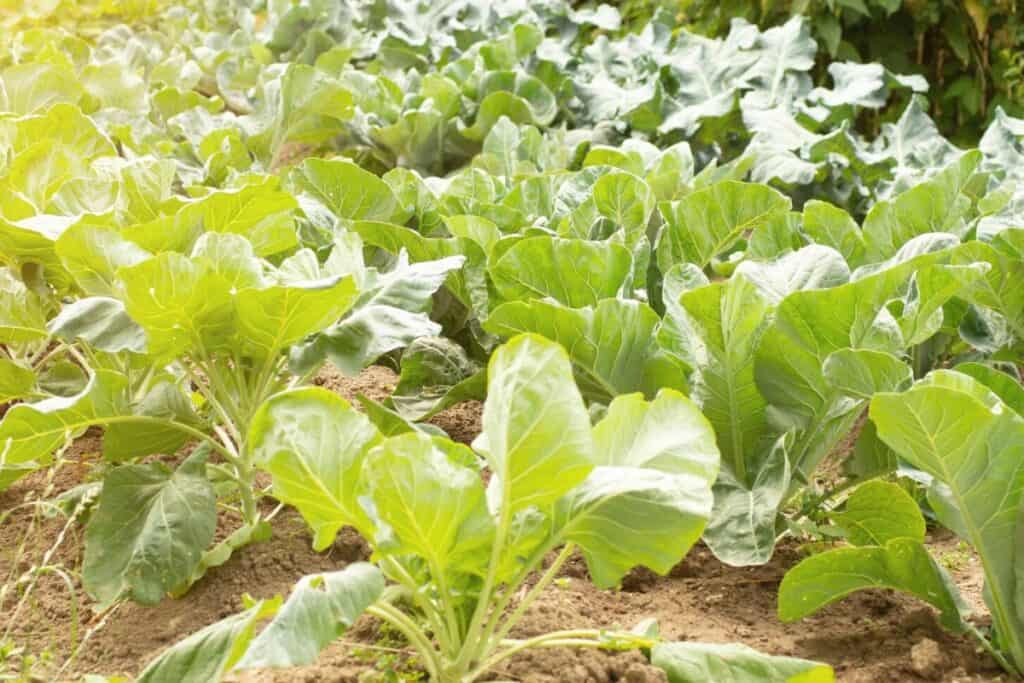
As discussed, it’s important to limit the depth of sawdust to 2 inches (5 cm). This isn’t usually enough to keep sandy soil cool or well-hydrated. In addition, the fine texture of sawdust can easily be incorporated into the porous sand.
Soil microbes will then feed on the sawdust because sandy soil doesn’t hold much nutrients. As the microbes break down the sawdust, they will consume whatever nitrogen is in the soil, resulting in nutrient-poor conditions for your vegetables.
That said, it’s best to use denser mulch materials like straw, pine needles, and grass clippings for sandy soil. Compost is excellent for sandy soil because as it degrades and works its way into the topsoil, it will improve the moisture retention and nutritional properties of the soil.
Over time, as you incorporate the decomposed organic mulch into the sandy soil, you’ll create a rich and suitable substrate for almost any vegetable. As the soil becomes richer in humus, it becomes loamy sand and can welcome even sawdust mulch.
Clay Soil
Vegetable seeds and seedlings need porous soil for the fragile roots to grow without restrictions. The soil must also drain well in order to prevent waterlogged conditions that can lead to root rot and crop failure.
Therefore, it’s best not to start a vegetable garden right away if your area has very clayey soil. No amount of mulch will improve your chances of growing vegetables in clayey soil.
Interestingly, compost is also great for clayey soil as it improves aeration. You can either amend the soil or create a raised vegetable garden where it’s easier to design and maintain the soil texture and quality.
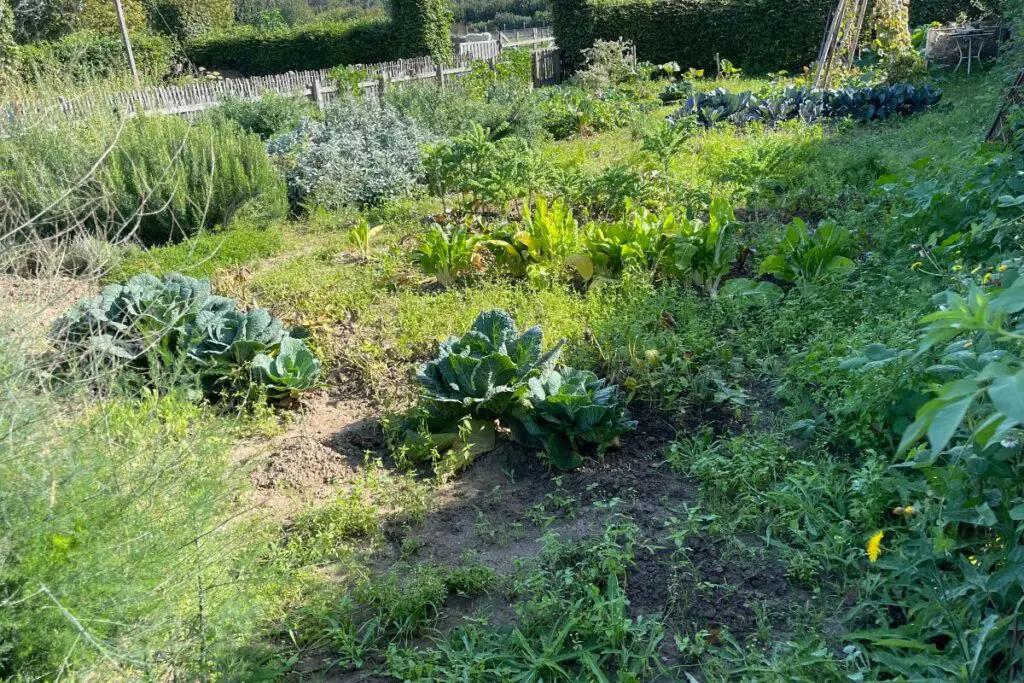
Gardener Preferences and Goals
If you’ve decided to take on vegetable gardening as part of your lifestyle, you may already have an idea or plan about what kind of vegetables to grow.
Here are some guidelines on how to choose mulch based on your preferences and goals:
Growing Non-Native Vegetable Species
The first thing farmers usually do is choose vegetables that are native to their climate and soil quality because they’ll be the easiest to grow. However, this shouldn’t keep you from aiming for those that are not native to your area.
Bark, wood chips, and straw mulch are excellent for overwintering perennial vegetables in areas with freezing winters.
If you have alkaline soil, you can use acidic compost as mulch in addition to your other soil-acidifying methods. As the mulch works its way into your soil, this will help maintain the acidity and require slightly less frequent applications of soil-acidifying amendments.
Aesthetics
Sawdust and wood chip mulch can come in different colors—natural or artificial—and you can choose the color that will match your garden’s aesthetics.
However, note that sawdust is not suitable for very cold regions or very sandy soil. Similarly, wood chip mulch is only suitable for perennial vegetables and fruit trees.
Straw mulch is also attractive, but only in the first few months. It will last in the soil for a long time, so it’s best to use it around slow-maturing vegetable cultivars or perennial ones.
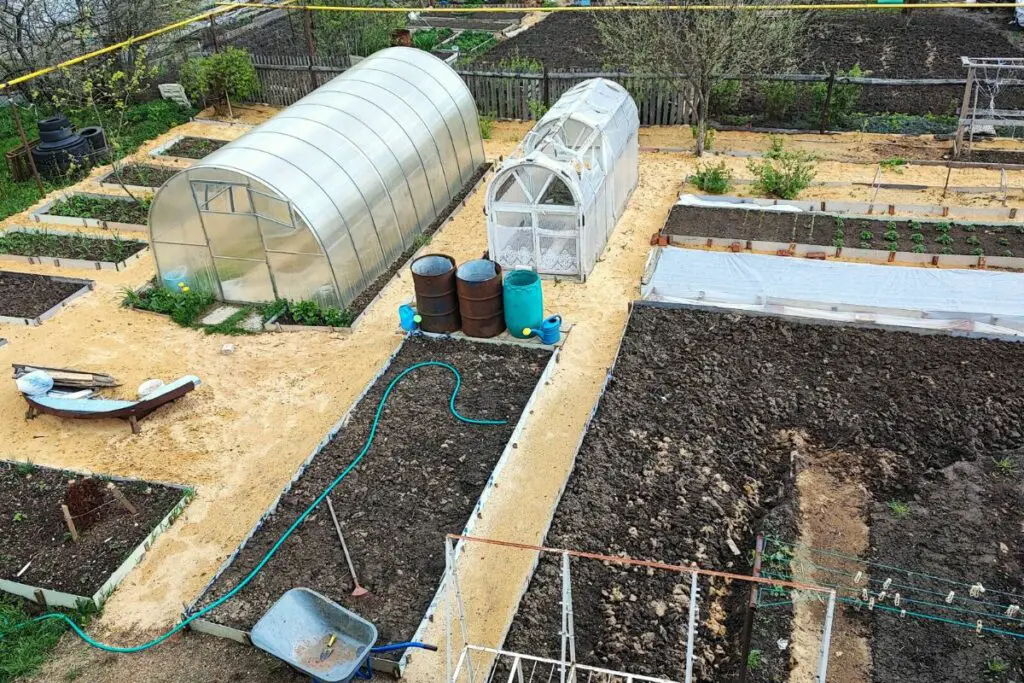
Application and Maintenance
In addition to knowing what kind of mulch best suits your vegetable garden, proper application and maintenance are crucial to maximizing the benefits of organic mulches.
Here are some guidelines on how to apply and maintain organic mulch in a vegetable garden.
Proper Depth and Coverage
In general, mulch can be applied to a depth of 4 inches (10 cm) except for fine sawdust, which should be limited to only 2 inches (5 cm). Nevertheless, the purpose of mulching can affect how deep the layer should be.
Here are some values to keep in mind:
- Seeding: 1-2 inches (2.5-5 cm)
- Winter protection: 3-4 inches (7.6-10 cm)
- Weed suppression: 2-4 inches (5-10 cm)
- Pathway: 4-6 inches (10-15 cm)
Your mulch layer should cover your entire vegetable garden, including 6-12 inches (15-30 cm) around it to prevent weeds from growing too close to your vegetable patch.
Replenishment and Top-Dressing
Organic mulch naturally decays over time and is absorbed by the soil. This process will thin the mulch layer and possibly reduce its effectiveness. Therefore, it’s important to keep an eye on how quickly the mulch decomposes and top it up promptly.
If the mulch loses significant volume (1 inch or 2.5 cm) during the growing season, it’s crucial to top it up with a fresh layer. For instance, if you applied mulch in spring, it’s crucial to check by the start of summer so you can protect the plant’s roots from the upcoming rise in temperatures.
You can replenish the mulch by adding only enough to make up for what was lost due to decomposition, heavy rain, or strong wind. If done properly, mulching can even extend your harvest of cool-season crops well into the early summer.
Similarly, the freeze and thaw cycles in winter can reduce the volume of organic mulches applied in the fall. You can inspect and loosen the mulch by raking it. This will help relieve the compaction that may have occurred due to frost.
For perennial vegetables, you can remove the partially decomposed mulch entirely and place it in the compost bin.
For annual seedlings, on the other hand, you can just create holes through the mulch down to the soil layer for transplanting. Add enough mulch for your purpose. For instance, if the mulch layer is down to an inch (2.5 cm) but you want to suppress weeds, you can top it up with 1-3 inches (2.5-7.6 cm) more.
Decomposition Management
Mulch decomposition rate can vary depending on the mulch type and how well you maintain your garden. A well-maintained garden has a healthy population of soil microbes that continue to break down organic matter and enrich the soil.
If the mulch is almost completely decomposed by the end of the growing season—with less than an inch (2.5 cm) left—you can till the remaining mulch into the top 4 inches (10 cm) of the soil to complete the decomposition process.
The organic mulch will increase the organic matter in your soil, but there may be some issues with carbon-rich mulches.
I’ve managed to maximize my vegetable garden by doing succession planting followed by crop rotation using tomatoes and beans or carrots. For instance, I started my tomato seeds early indoors, 4-6 weeks before the last frost.
I fertilized the soil using a balanced (10-10-10) NPK granular fertilizer about three weeks before transplanting. After placing them in the garden and applying sawdust mulch, I just kept an eye on their watering needs.
After harvesting my early batch of tomatoes in late spring, I removed the plants (composting the roots and debris) and prepared the soil for bean planting in the following weeks. The last batch of tomatoes was then replaced with carrots for a fall harvest right after the first frost.
I only had to apply another dose of fertilizer before growing the new batch of crops. Some gardeners are worried that straw and woody mulches can consume nitrogen during decomposition.
However, vegetables like carrots and beans don’t need much nitrogen and will grow just well in the soil with partially decomposed organic mulch. You may need to top up your mulch, though, if the depth becomes less than when you first applied it.
In addition, beans convert nitrogen gas from the atmosphere into ammonia that can be used by soil microbes. These microbes can then release this ammonia into the soil in the form of nitrates, which can be utilized by your future plants.
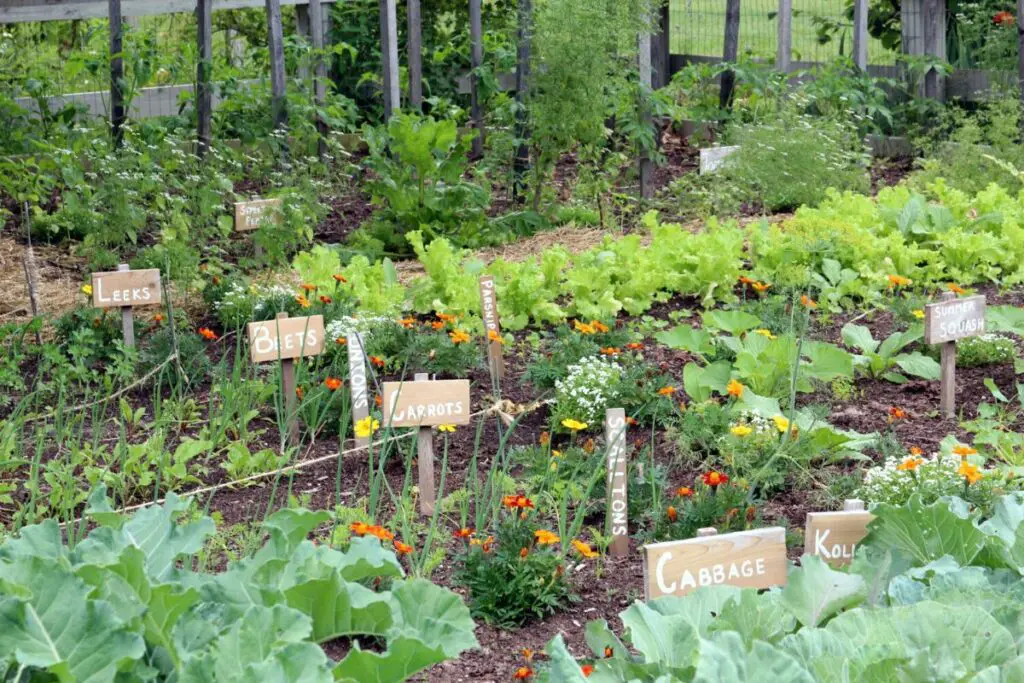
Final Thoughts
Organic mulches are excellent for vegetable gardens because they provide protection from fluctuating temperatures, rapid moisture loss, and weeds. They also enrich the soil as they break down.
Many organic materials will work well in a vegetable garden, including the following:
- Compost
- Straw
- Grass clippings
- Pine needles
- Sawdust
- Dried leaves
- Wood chips and bark
- Cover crops
However, among all these, homemade compost is the best because it doesn’t present any nutritional deficiency issues. You can even use partially decomposed compost as mulch in the fall in temperate regions, as it can help keep the soil warm in winter.
Overall, understanding your mulch’s qualities, your vegetables’ growth requirements, and your region’s climate and soil conditions will help you plan your vegetable garden more efficiently.

